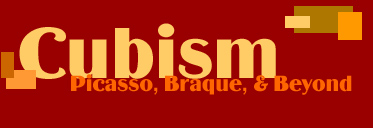

Addressed here are brief discussions of two key influences on the Cubist artists and movement--music and literature. I also chose to address a unique theory on the role of mental illness in Picasso's artwork, which I found interesting because it is a theory commonly used to explain artistic genius in many artists of all kinds.Musicis a common theme in Cubist artwork, particularly in works by Picasso and Braque. Georges Braque openly acknowledged the way in which music influenced his artwork. Many sources cite Braque as being surrounded by musical instruments in his studio. Not surprisingly then, Anne Gantefuhrer-Trier credits Braque with being the "first Cubist artist to integrate musical instruments into [his] compositions" (Gantefuhrer-Trier 42). Isabelle Monod-Fontaine quotes Braque directly about his musically inspired works.
Despite the fact that Picasso has used musical instruments as frequently in his artwork as Braque, he has always claimed that music has not had an influence in his work and essential, he couldn't care less or know less about it. However, Gantefuhrer-Trier makes an agreeable point that this is hard to believe because not only does he utilize musical themes so frequently, he also draws associations between instruments and the feminine form, such as in his painting Girl with a Mandolin (Fanny Tellier) (Gantefuhrer-Trier 50)."At that time I painted a lot of musical instruments, firstly because I was surrounded by them and then because their form, their volume, came into the realm of the still life exactly as I wanted. I was seeking a tactile, palpable space as I like to call it, and musical instruments, as objects, also have this characteristic, you can bring them to life by touching them"(Monod-Fontaine 65).

Girl with a Mandolin (Fanny Tellier)
Pablo Picasso, 1910
Oil on canvas, 100.3 x 73.6 cm
The Museum of Modern Art, New York City, Nelson A. Rockefeller Bequest
(from On-line Picasso Project)Stewart Buettner conducted an extensive study in 1996 which explored the possible connections between Picasso, Braque, and music based on Picasso and Braque's time spent in Catalonia and Barcelona. Some light might be shed on Picasso's connection to music, despite his denial. According to Buettner's research, Picasso had musicians in his family and of course had been exposed to musicians within the artistic community and in his traveling. Another key point of interest which Buettner suggests is that many of these musical subjects were inspired by live performances, suggested by the introduction of musical notes into both the works of Picasso and Braque (Buettner 102-104, 108).
Literature has also been credited with having a marked influence on the cubist movement. First, it is well noted that artists including Picasso were acquainted with writers and poets in particular within the artistic community (Brighton & Klimowski 34). The comparison between art and poetry is not a recent concept, and cubism is no exception. Due to its defined shapes, lines, and colors, cubism is particular susceptible to being read like poetry.
In a historical context, the cubist movement was paralleling a change in the literary world in the late nineteenth and early twentieth centuries. Free verse was becoming a new mode of literary expression that emphasized rhythm and the precise combination of word sounds. According to the study of literary and artistic parallels by Daniel J. Robbins, the literary innovation of free verse and its abstract qualities had an influence in cubism, as many cubist artists were acquainted with prominent innovators in poetry (Robbins 324-326).
Neil Cox also draws similar comparisons between cubist artwork and "visual rhymes." He specifically mentions Braque's piece Pedestal Table, which has musical elements such as notes that he argues can be deciphered as having a poetic rhythm (Cox 247-249).

Pedestal Table
Georges Braque, autumn 1911
Oil on canvas, 116.5 x 81.5 cm
Georges Pompidou Center, Paris
(image: ArtLex Art Dictionary)Migraines, in rare cases, can produce visualizations that are similar to what exemplifies Picasso's later works, according to a theory presented by Doctor Michael D. Ferrari (Woodard 1). It is hard to give such theories much consideration, because so many "artistic geniuses" have been said to have mental illnesses, most commonly severe depression. While depression does seem like a common motivation to produce artwork, it is much more feasible than rare migraine symptoms. Dr. Ferrari suggests in his theory that Picasso's later works (1930s) show a "vertical splitting of the field of vision," a symptom of migraines that is rare but can happen just once even without the headache, which he believes might be Picasso's case (Woodard 1).
This theory might also just be another attempt by the scientific community to rationalize "artistic genius" with scientific explanation. While the theory is interesting, it is more entertaining than feasible. The following work is an example of the the works referred to in Dr. Ferrari's theory.

La femme qui pleure
Pablo Picasso, October 1937
Oil on canvas, 55 x 46 cm
National Gallery of Victoria, Melbourne
(image: On-line Picasso Project)